Baby Giants
Ken Neill
Published in Angler Magazine
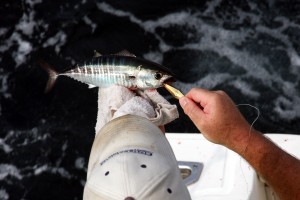 During the months of fall, the Healthy Grin will be offshore fishing for tuna. Tuna fishing can be great this time of year so there will be a lot of boats out there fishing for tuna with us. We will be doing it wrong.
During the months of fall, the Healthy Grin will be offshore fishing for tuna. Tuna fishing can be great this time of year so there will be a lot of boats out there fishing for tuna with us. We will be doing it wrong.
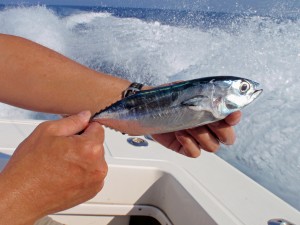 Instead of the typical spreader bars and ballyhoo baits, we will be out there trolling little spoons on light tackle. Basically, we look like lost Spanish mackerel fishermen. We are not lost; it is just that the tuna we are targeting are about ten inches long.
Instead of the typical spreader bars and ballyhoo baits, we will be out there trolling little spoons on light tackle. Basically, we look like lost Spanish mackerel fishermen. We are not lost; it is just that the tuna we are targeting are about ten inches long.
 Researchers at the Virginia Institute of Marine Science and other institutions are very interested in very small bluefin tuna, the young-of-the-year (YOY). Bluefin tuna are one of the most valuable, controversial, closely regulated, and sought after fish in the sea. They grow to mammoth proportions, fetch ridiculous prices in the fish markets, and are one of the most challenging catches for sport fishermen.
Researchers at the Virginia Institute of Marine Science and other institutions are very interested in very small bluefin tuna, the young-of-the-year (YOY). Bluefin tuna are one of the most valuable, controversial, closely regulated, and sought after fish in the sea. They grow to mammoth proportions, fetch ridiculous prices in the fish markets, and are one of the most challenging catches for sport fishermen.
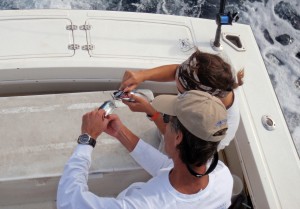 The population of bluefin tuna is thought to be greatly depressed. This causes very strict regulations with a very limited catch allowed. The various recreational and commercial groups vie with each other and amongst themselves for a slice of the bluefin pie. At times, on the water, bluefin tuna fishing is very, very good, leading some to question just how depressed the population really is.
The population of bluefin tuna is thought to be greatly depressed. This causes very strict regulations with a very limited catch allowed. The various recreational and commercial groups vie with each other and amongst themselves for a slice of the bluefin pie. At times, on the water, bluefin tuna fishing is very, very good, leading some to question just how depressed the population really is.
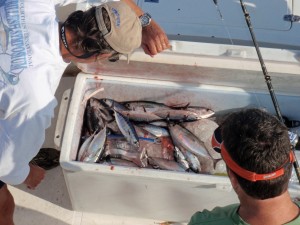 On top of the domestic efforts to manage (and to catch) bluefin tuna, bluefin tuna are an international hot potato. Every country wants their share and there is disagreement on how to manage this very important species. Atlantic bluefin tuna are considered to be two distinct stocks: western and eastern Atlantic. The western stock (ours) is considered to be in worse shape than the eastern (European) stock. The fish are managed as two distinct stocks but how valid is this approach?
On top of the domestic efforts to manage (and to catch) bluefin tuna, bluefin tuna are an international hot potato. Every country wants their share and there is disagreement on how to manage this very important species. Atlantic bluefin tuna are considered to be two distinct stocks: western and eastern Atlantic. The western stock (ours) is considered to be in worse shape than the eastern (European) stock. The fish are managed as two distinct stocks but how valid is this approach?
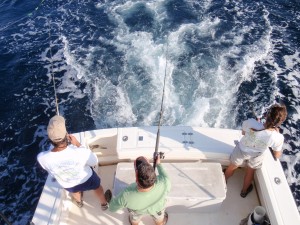 Conventional tagging techniques did not tell us too much about the movements of bluefin tuna due to very low return rates. The newer, pop-up satellite tags have punched some holes in the two separate stocks theory. Their use continues to help us to learn more about bluefin tuna (and other species) all the time. These tags have shown that bluefin tuna do indeed cross the Atlantic Ocean. The question remains, just how distinctly separate are western and eastern Atlantic bluefin tuna populations?
Conventional tagging techniques did not tell us too much about the movements of bluefin tuna due to very low return rates. The newer, pop-up satellite tags have punched some holes in the two separate stocks theory. Their use continues to help us to learn more about bluefin tuna (and other species) all the time. These tags have shown that bluefin tuna do indeed cross the Atlantic Ocean. The question remains, just how distinctly separate are western and eastern Atlantic bluefin tuna populations?
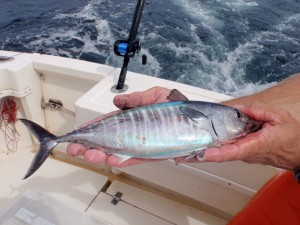 That is where we come in. The Healthy Grin has a special permit to collect YOY bluefin tuna for the scientists to study. These tuna are born in the Gulf of Mexico and work their way up the Atlantic seaboard. They have not had time to cross the Atlantic Ocean making them purely western Atlantic bluefin tuna. Other YOY bluefin tuna are collected from the eastern Atlantic. This allows the scientist to study the DNA of the two stocks to determine just how distinct they are genetically. It also allows them to develop a baseline of various chemical compounds that accumulate in the tissues of the fish over a lifetime. By looking at these chemical concentrations in older fish, scientists are able to develop an estimate of how much the fish’s life is spent in various parts of the ocean.
That is where we come in. The Healthy Grin has a special permit to collect YOY bluefin tuna for the scientists to study. These tuna are born in the Gulf of Mexico and work their way up the Atlantic seaboard. They have not had time to cross the Atlantic Ocean making them purely western Atlantic bluefin tuna. Other YOY bluefin tuna are collected from the eastern Atlantic. This allows the scientist to study the DNA of the two stocks to determine just how distinct they are genetically. It also allows them to develop a baseline of various chemical compounds that accumulate in the tissues of the fish over a lifetime. By looking at these chemical concentrations in older fish, scientists are able to develop an estimate of how much the fish’s life is spent in various parts of the ocean.
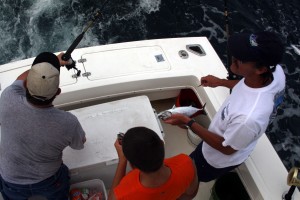 Well, that is the reason why we are asked to be a fleet of one, searching for baby bluefin off of our coast. We do it because it is just dang fun. The action can be nonstop. There is not much out there that will not bite a little shiny spoon. Pulling a spread of small spoons behind planers, small lures, and mini cedar plugs; our baits are near the bottom of the food chain. We catch all kinds of stuff.
Well, that is the reason why we are asked to be a fleet of one, searching for baby bluefin off of our coast. We do it because it is just dang fun. The action can be nonstop. There is not much out there that will not bite a little shiny spoon. Pulling a spread of small spoons behind planers, small lures, and mini cedar plugs; our baits are near the bottom of the food chain. We catch all kinds of stuff.
 Most of what we land are small fish. Larger predators typically just bite our baits off or result in straightened hooks. We do get bites though, a lot of bites. Each trip results in a surprising collection of good by-catch. During our baby bluefin trips we have brought in catches of nice dolphin, a bunch of blackfin tuna, larger bluefin tuna to over one hundred pounds, keeper yellowfin tuna, and citation-size wahoo. We have even scored white marlin releases on these trips. You just have to take your time, use a light drag, and be a bit lucky.
Most of what we land are small fish. Larger predators typically just bite our baits off or result in straightened hooks. We do get bites though, a lot of bites. Each trip results in a surprising collection of good by-catch. During our baby bluefin trips we have brought in catches of nice dolphin, a bunch of blackfin tuna, larger bluefin tuna to over one hundred pounds, keeper yellowfin tuna, and citation-size wahoo. We have even scored white marlin releases on these trips. You just have to take your time, use a light drag, and be a bit lucky.
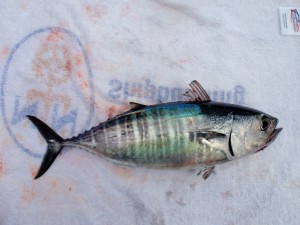 When we are offshore fishing for “real” fish, you will not find these miniature baits in our trolling spread. But if you are out there on one of those days that the ocean seems devoid of life and you cannot but a bite, you might want to put a tiny spoon in your spread. I bet you get bit!
When we are offshore fishing for “real” fish, you will not find these miniature baits in our trolling spread. But if you are out there on one of those days that the ocean seems devoid of life and you cannot but a bite, you might want to put a tiny spoon in your spread. I bet you get bit!
